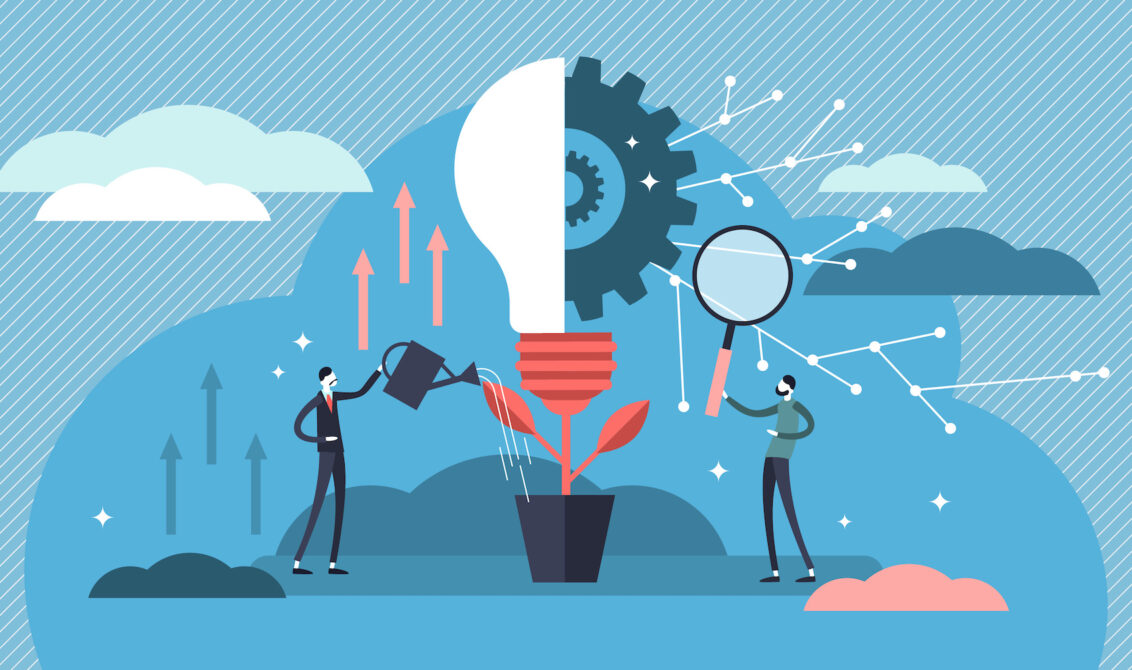Most people tend to think of innovation as creativity. Some might even think of it as one big brainstorming session that magically evolves into something great. This line of thinking fails to recognize the inherent steps of innovation and the accompanying process skills and talents required to innovate and bring that creation into reality.
The innovation process requires four steps: Generating, conceptualizing, optimizing, and implementing. The process is circular because solutions and actions bring about new challenges and opportunities for individuals, teams, and organizations.
Anyone can be comfortable with and excel in each of these steps, but most people have preferences for a particular stage and the activities associated with it. Those with preferences for generation, conceptualization, optimization, and implementation all play a critical role in the innovation process. Their engagement in a venture, project, or initiative may vary based on their needs at any given time — and that’s okay. In fact, it’s healthy!
One way to think about this is through four sets of preferences. Generators and conceptualizers prefer using information for ideation, while conceptualizers and optimizers prefer to learn through ideation over evaluation. Optimizers and implementers, on the other hand, prefer evaluation over ideation. Likewise, implementers and generators prefer gathering information through direct experiences over detached abstract thinking, while conceptualizers and optimizers prefer detached abstract thinking over experiencing.
Let’s take a closer look at these four style preferences.
1. Generators
Those with a strong preference for generating — or generators — enjoy coming up with ideas and exploring possibilities. They value the perspective of others and want to involve people. They like to keep their options open, and thus, are comfortable with ambiguity. Generators are in short supply (less than 10% of the working population), so it’s important to recognize what they can bring to the creative process and empower them to bring their contributions.
2. Conceptualizers
Conceptualizers also prefer ideation and like to keep their options open. They enjoy refining ideas through research and testing. Conceptualizers are skilled at putting the pieces together into a plan or strategy, and they’re especially gifted at making sure the team is working on the right problem or opportunity. It’s important for those who have a strong preference for conceptualization to be willing to move forward with a “good enough” plan, strategy, or product, as they tend to want to over-perfect due to their comfort with inaction.
3. Optimizers
Like conceptualizers, strong optimizers like to research best practices, but their goal is maximization, scaling, and risk management. They recognize the importance of standards and build systems and processes to maximize potential and manage growth, and the higher volume of activity that comes with it. Those with a strong inclination towards optimization can be the ones who tend to “pour cold water” over ideas with quick judgment.
4. Implementers
Implementers are most plentiful in the workforce (40-45%), and for good reason: Success is nearly impossible to achieve without action orientation that leads to measurable results. Those with a strong preference for implementation are reliable and get things across the finish line. They are quick thinkers who react accordingly to problems that need nearly instant solutions. Managers and leaders love implementers because they can count on them to deliver, even under tense circumstances. A word of caution for implementers, though: They can sometimes abandon plans and systems too quickly. They’re also often reluctant to share feedback with conceptualizers and optimizers, which can lead to a vicious cycle of recycling failed or non-optimal solutions.
“The important concept to grasp is that it takes a cognitively diverse team to come up with and execute innovative solutions with success”
The important concept to grasp is that it takes a cognitively diverse team to come up with and execute innovative solutions with success. People with all four styles can and should participate in part of or the entire innovation process, but it may be helpful to allow those with stronger preferences to lead — formally or informally — the different steps of the process.
Generators are great at activating a venture and broadening thinking and potential options. They include a wide array of perspectives and help the team stretch. Conceptualizers vet those ideas and reframe them into the “real” path to pursue. They put a plan together and pass it along to optimizers, who professionalize the venture or project by adding structure, standards, and systems. Implementers take the plan and system and move forward with urgency toward results.
Interestingly, our emergent research indicates that idea people — generators and conceptualizers — are more comfortable with the idea of starting an entrepreneurial venture or launching a corporate innovation project. Given that new ventures and projects stall out because of inaction, too much chaos (a lack of structure), or a lack of financial results, this could go a long way toward explaining the high failure rates of entrepreneurial ventures.
Suppose you are building teams for new ventures, projects, or innovation. In that case, your first step should be to identify who will be on those teams, or even sub-teams, by examining the talents and skills necessary to effectively get through the innovation process.
For more information on building diverse venture and innovation teams, visit Basadurprofile.com and ELProfile.com.
Rob Mathews is the Executive Director of the Entrepreneurial Leadership Institute at Ball State University. His new book with co-authors Min Basadur and Michael Goldsby is Design-Centered Entrepreneurship, Second Edition (Routledge, 2022), and provides a research-driven, step-by-step approach to creative problem-solving. Learn more at elprofile.com and basadurprofile.com.
© YFS Magazine. All Rights Reserved. Copying prohibited. All material is protected by U.S. and international copyright laws. Unauthorized reproduction or distribution of this material is prohibited. Sharing of this material under Attribution-NonCommercial-NoDerivatives 4.0 International terms, listed here, is permitted.














